CHEVROLET SUBURBAN 1997 Owner's Manual
Manufacturer: CHEVROLET, Model Year: 1997, Model line: SUBURBAN, Model: CHEVROLET SUBURBAN 1997Pages: 433, PDF Size: 21.49 MB
Page 21 of 433
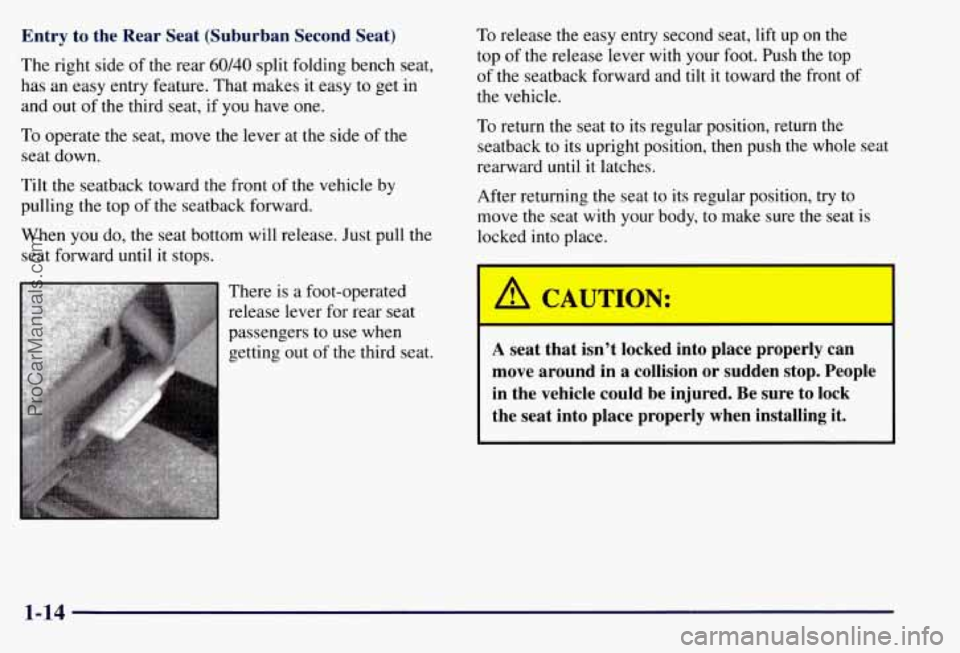
Entry to the Rear Seat (Suburban Second Seat)
The right side of the rear 60/40 split folding bench seat,
has an easy entry feature. That makes it easy to get in
and
out of the third seat, if you have one.
To operate the seat, move the lever at the side of the
seat down.
Tilt the seatback toward
the front of the vehicle by
pulling the top
of the seatback forward.
When you do, the seat bottom will release. Just pull the
seat forward until it stops.
There is a foot-operated
release lever for rear seat
passengers to use when
getting out of the third seat. To
release the easy entry second seat, lift up on the
top of the release lever with your foot. Push the top
of the seatback forward and tilt it toward the front of
the vehicle.
To return the seat to its regular position, return the
seatback
to its upright position, then push the whole seat
rearward until it latches.
After returning the seat to its regular position, try
to
move the seat with your body, to make sure the seat is
locked into place.
I /!1 CAUTION:
A seat that isn’t locked into place properly can
move around in a collision or sudden stop. People
in the vehicle could be injured. Be sure to lock
the seat into place properly when installing it.
1-14
ProCarManuals.com
Page 22 of 433
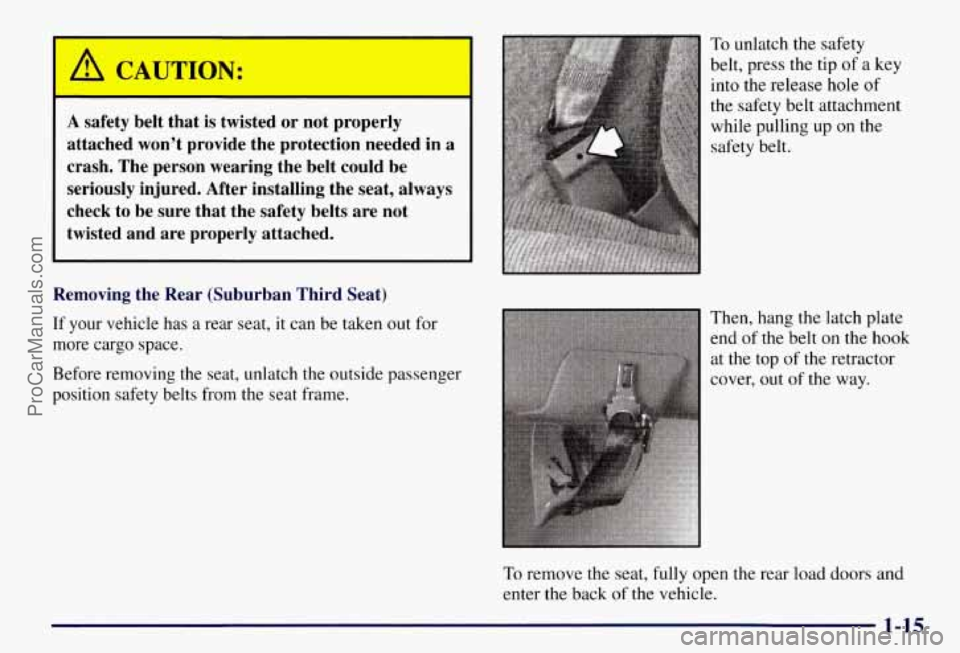
A safety belt that is twisted or not properly
attached won’t provide the protection needed in
a
crash. The person wearing the belt could be
seriously injured. After installing the seat, always
check to be sure that the safety belts are not
twisted and are properly attached.
Removing the Rear (Suburban Third Seat)
If your vehicle has a rear seat, it can be taken out for
more cargo space.
Before removing the seat, unlatch the outside passenger
position safety belts from the seat frame.
To unlatch the safety
belt, press the tip
of a key
into the release hole of
the safety belt attachment
while pulling up
on the
safety belt.
Then, hang the latch plate
end of the belt
on the hook
at the top of the retractor
cover, out
of the way.
To remove the seat, fully open the rear load doors and
enter the back
of the vehicle.
1-15
ProCarManuals.com
Page 23 of 433
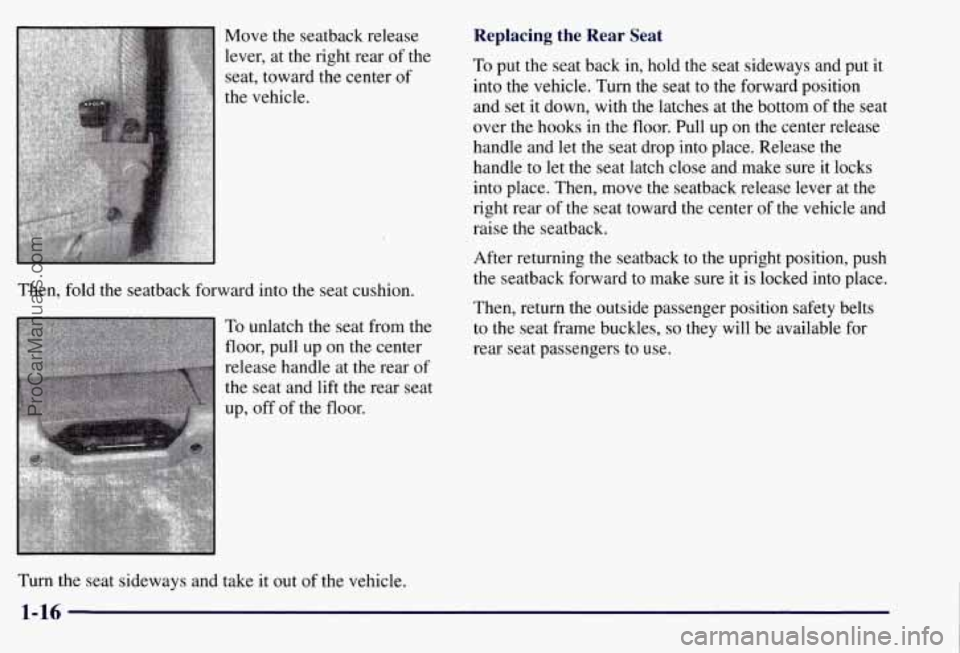
Move the seatback release
lever, at the right rear
of the
seat, toward the center
of
the vehicle.
Then, fold the seatback forward into the seat cushion.
To unlatch the seat from the
floor, pull up on the center
release handle at the rear of
the seat and lift the rear seat
up, off of the floor.
Turn the seat sideways and
take it out of the vehicle.
Replacing the Rear Seat
To put the seat back in, hold the seat sideways and put it
into the vehicle. Turn
the seat to the forward position
and set it down, with the latches at the bottom
of the seat
over the hooks in the floor. Pull up
on the center release
handle and let the seat drop into place. Release the
handle to let the seat latch close and make sure it locks
into place. Then, move the seatback release lever at the
right rear of the seat toward the center
of the vehicle and
raise the seatback.
After returning the seatback to the upright position, push
the seatback forward to make sure it is locked into place.
Then, return the outside passenger position safety belts
to the seat frame buckles, so they will be available for
rear seat passengers to use.
1-16
ProCarManuals.com
Page 24 of 433
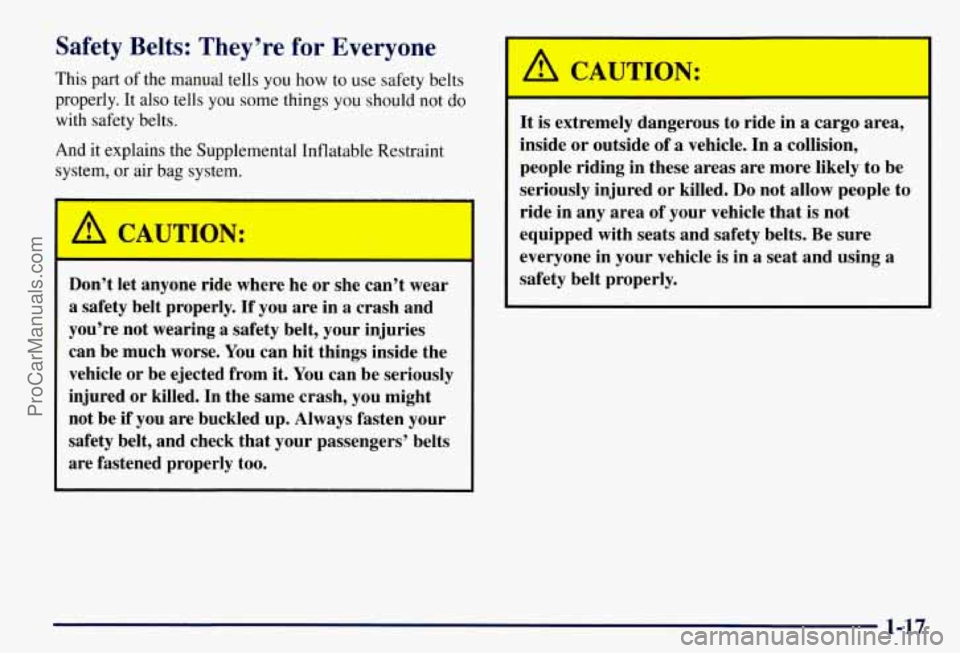
Safety Belts: They’re for Everyone
This part of the manual tells you how to use safety belts
properly. It also tells you some things you should not
do
with safety belts.
And it explains
the Supplemental Inflatable Restraint
system, or air bag system.
Don’t let anyone ride where he or she can’t wear
a safety belt properly.
If you are in a crash and
you’re not wearing a safety belt, your injuries
can be much worse. You can hit things inside the
vehicle or be ejected from it. You can be seriously
injured or killed.
In the same crash, you might
not be if you are buckled up. Always fasten your
safety belt, and check that your passengers’ belts
are fastened properly too. It
is extremely dangerous to ride in
a cargo area,
inside or outside of a vehicle. In a collision,
people riding in these areas are more likely to be
seriously injured or killed.
Do not allow people to
ride in any area of your vehicle that is not
equipped with seats and safety belts. Be sure
everyone in your vehicle is in a seat and using a
safety belt properly.
1-17
ProCarManuals.com
Page 25 of 433
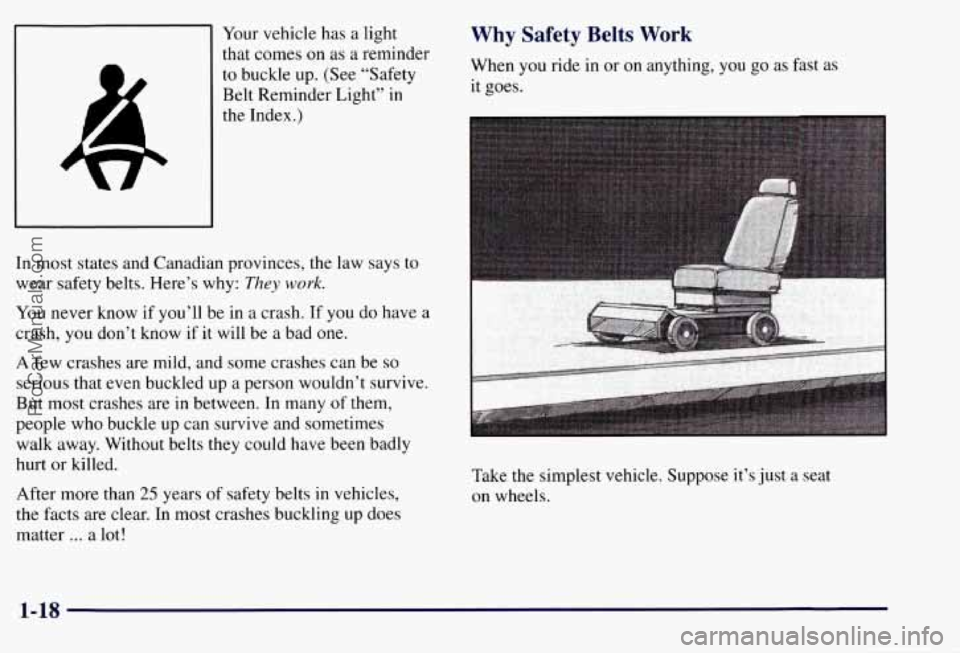
Your vehicle has a light
that comes on as a reminder
to buckle up. (See “Safety
Belt Reminder Light” in
the
J
Index.)
In most states and Canadian provinces, the law says to
wear safety belts. Here’s why:
They work.
You never know if you’ll be in a crash. If you do have a
crash, you don’t know if it will be a bad one.
A few crashes are mild, and some crashes can be
so
serious that even buckled up a person wouldn’t survive.
But most crashes are in between. In many of them,
people who buckle up can survive and sometimes
walk away. Without belts they could have been badly
hurt
or killed.
After more than
25 years of safety belts in vehicles,
the facts are clear. In most crashes buckling up does
matter
... a lot!
Why Safety Belts Work
When you ride in or on anything, you go as fast as
it goes.
Take the simplest vehicle. Suppose it’s just a seat
on wheels.
1-18
ProCarManuals.com
Page 26 of 433
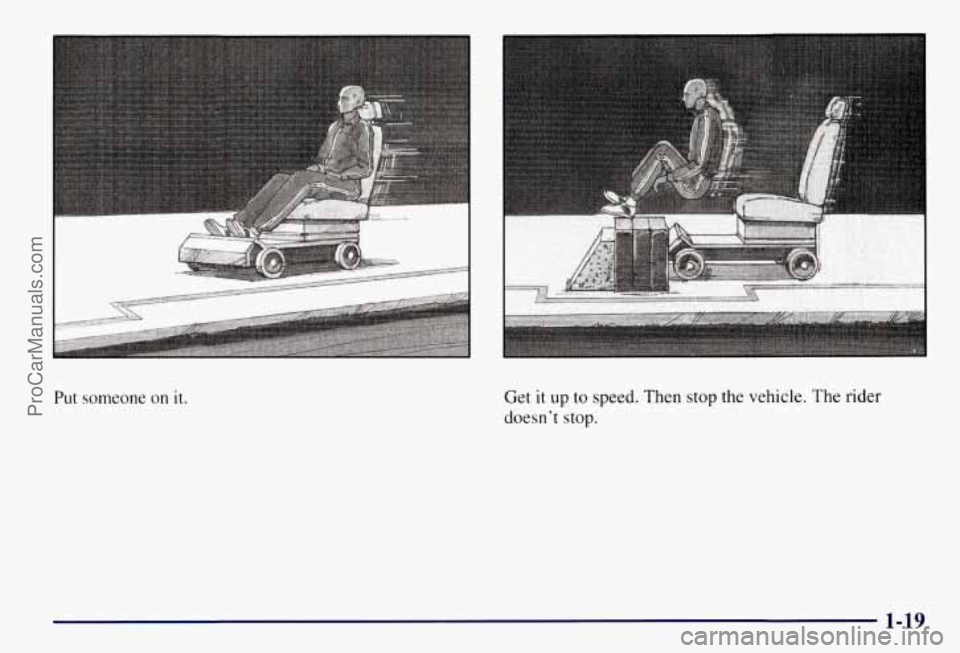
Put someone on it. Get it up to speed. Then stop the vehicle. The rider
doesn’t stop.
1-19
ProCarManuals.com
Page 27 of 433
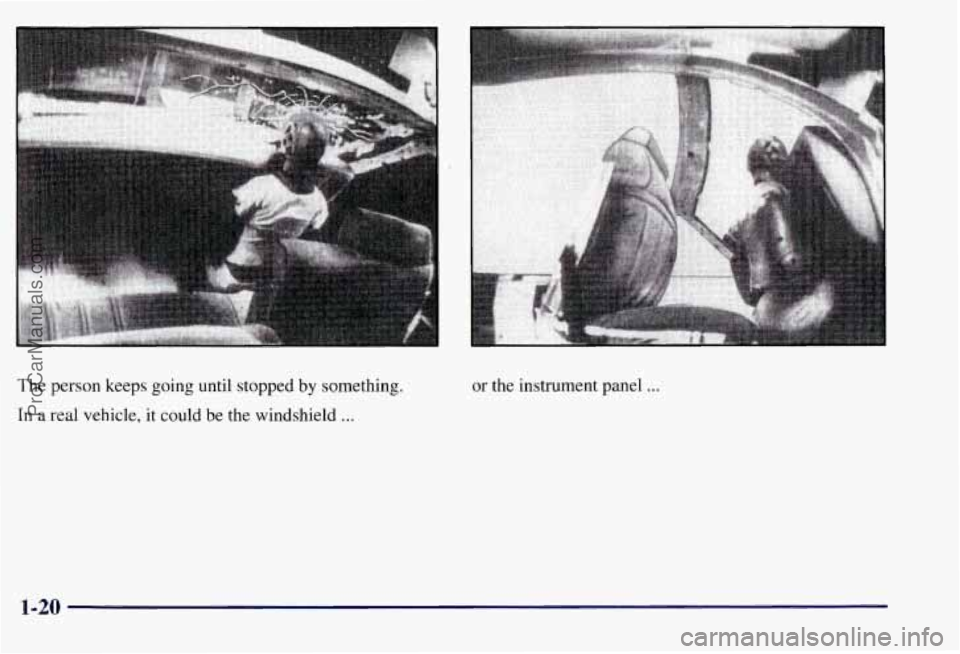
The person keeps going until stopped by something.
In a real vehicle, it could be the windshield
...
or the instrument panel ...
1-20
ProCarManuals.com
Page 28 of 433
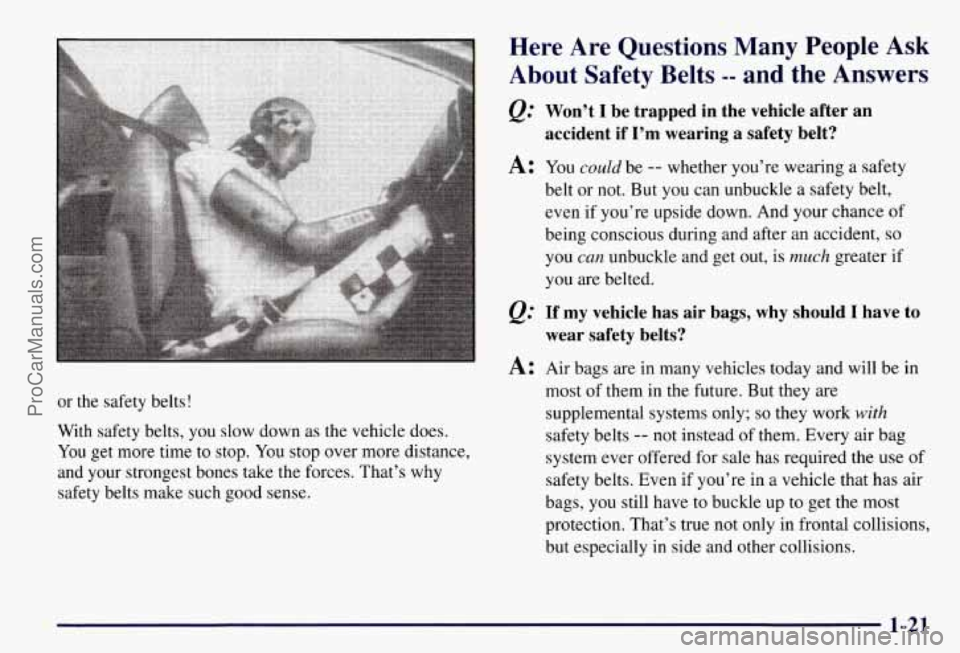
or the safety belts!
With safety belts, you slow down as the vehicle does.
You get more time to stop. You stop over more distance,
and your strongest bones take the forces. That’s why
safety belts make such good sense.
Here Are Questions Many People Ask
About Safety Belts
-- and the Answers
@’ Won’t I be trapped in the vehicle after an
accident if
I’m wearing a safety belt?
A: You couEd be -- whether you’re wearing a safety
belt or not. But you can unbuckle a safety belt,
even if you’re upside down. And your chance of
being conscious during and after an accident,
so
you can unbuckle and get out, is much greater if
you are belted.
&= If my vehicle has air bags, why should I have to
wear safety belts?
A: Air bags are in many vehicles today and will be in
most of them in the future. But they
are
supplemental systems only; so they work with
safety belts -- not instead of them. Every air bag
system ever offered for sale has required the use of
safety belts. Even if you’re in a vehicle that has air
bags, you still have to buckle up to get the most
protection. That’s true not only in frontal collisions,
but especially in side and other collisions.
1-21
ProCarManuals.com
Page 29 of 433
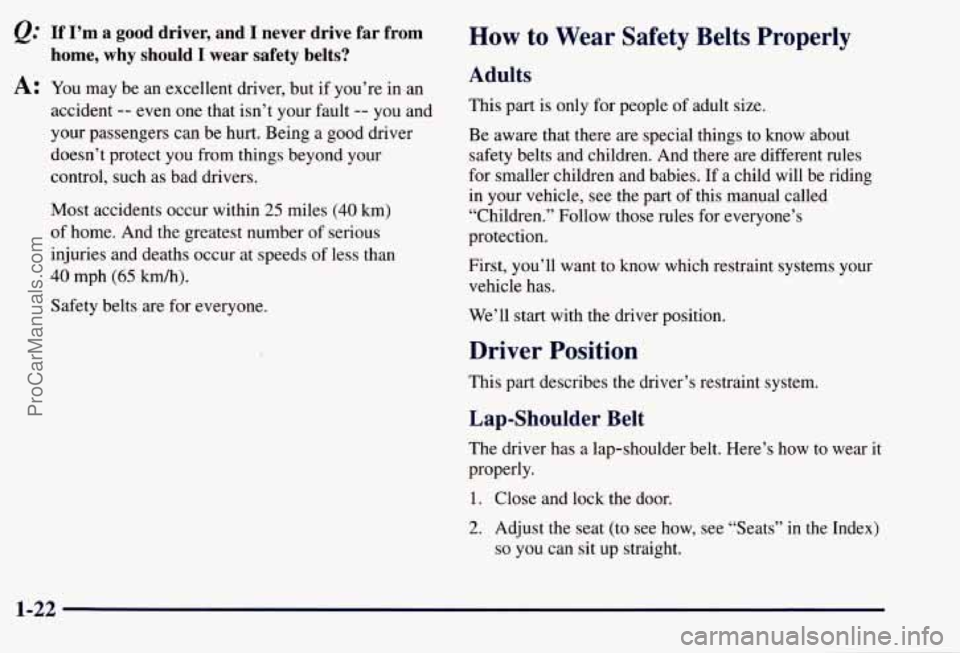
If I’m a good driver, and I never drive far from
home, why should
I wear safety belts?
A: You may be an excellent driver, but if you’re in an
accident
-- even one that isn’t your fault -- you and
your passengers can be hurt. Being a good driver
doesn’t protect you from things beyond your
control, such as bad drivers.
Most accidents occur within
25 miles (40 km)
of home. And the greatest number of serious
injuries and deaths occur at speeds of less than
40 mph (65 kmh).
Safety belts are for everyone.
How to Wear Safety Belts Properly
Adults
This part is only for people of adult size.
Be aware that there
are special things to know about
safety belts and children. And there are different rules
for smaller children and babies. If a child will be riding
in your vehicle, see the part of this manual called
“Children.” Follow those rules for everyone’s
protection.
First, you’ll want to know which restraint systems your
vehicle has.
We’ll start with
the driver position.
Driver Position
This part describes the driver’s restraint system.
Lap-Shoulder Belt
The driver has a lap-shoulder belt. Here’s how to wear it
properly.
1. Close and lock the door.
2. Adjust the seat (to see how, see “Seats” in the Index)
so you can sit up straight.
1-22
ProCarManuals.com
Page 30 of 433
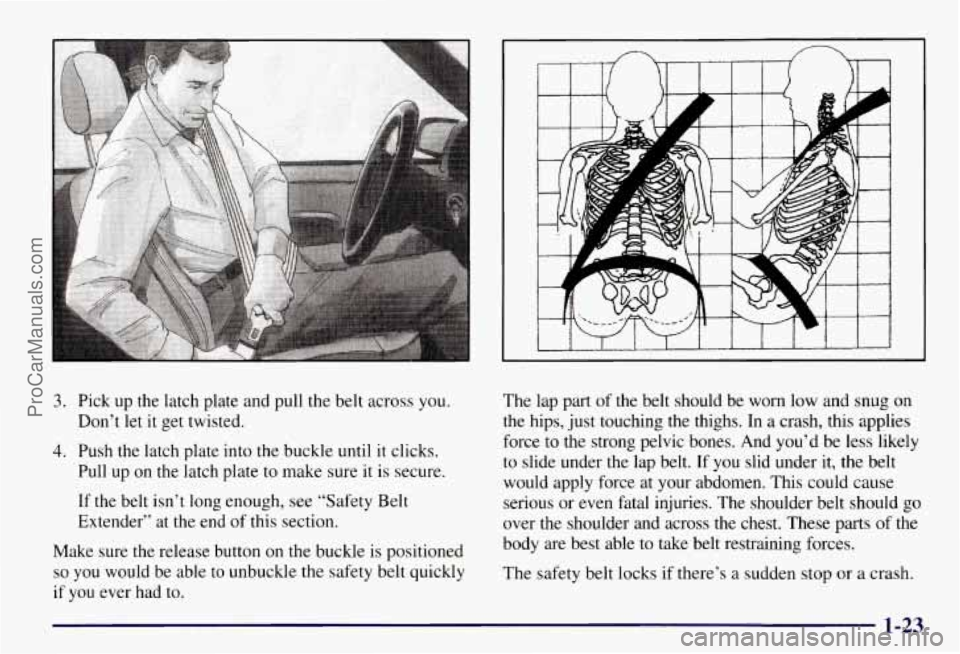
3. Pick up the latch plate and pull the belt across you.
Don’t let
it get twisted.
4. Push the latch plate into the buckle until it clicks.
Pull up on the latch plate
to make sure it is secure.
If the belt isn’t long enough, see “Safety Belt
Extender” at the end
of this section.
Make sure the release button on the buckle is positioned
so you would be able to unbuckle the safety belt quickly
if
you ever had to.
I-1 I I I I 1
The lap part of the belt should be worn low and snug on
the hips, just touching the thighs. In a crash, this applies
force to the strong pelvic bones. And you’d be less likely
to slide under the lap belt.
If you slid under it, the belt
would apply force at your abdomen. This could cause
serious or even fatal injuries. The shoulder belt should go
over the shoulder and across the chest. These
parts of the
body are best able to take belt restraining forces.
The safety belt locks
if there’s a sudden stop or a crash.
1-23
ProCarManuals.com